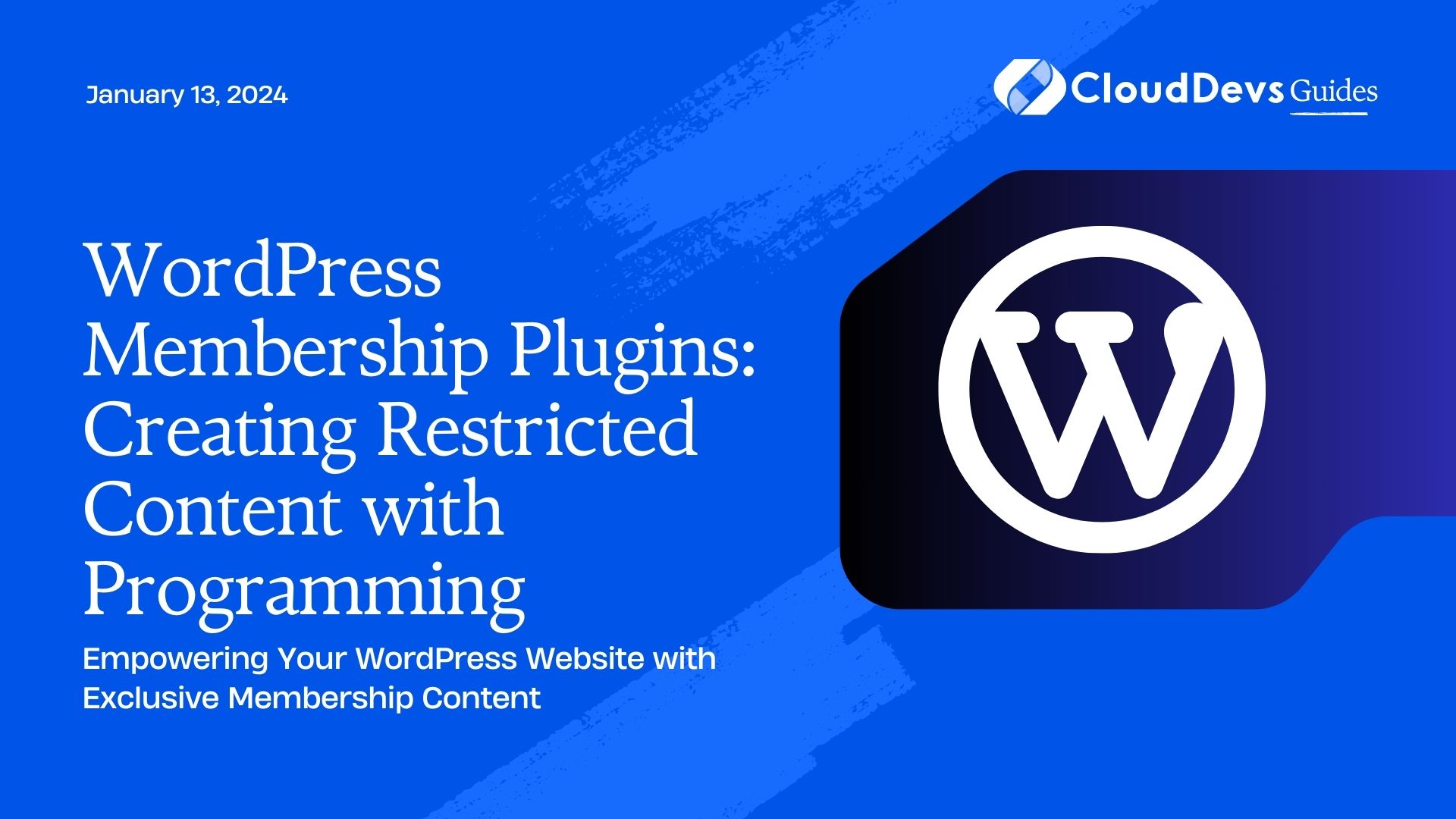WordPress Membership Plugins: Creating Restricted Content with Programming
In today’s digital landscape, websites often rely on providing unique and valuable content to their audience. This is where WordPress membership plugins come into play, offering site owners the ability to provide exclusive access to certain content for their registered members. While many membership plugins offer user-friendly interfaces for content restriction, there might be instances where you want to take a more customized and programmatic approach. In this article, we’ll delve into the world of WordPress membership plugins and explore how to create restricted content programmatically. We’ll cover essential concepts, provide code samples, and guide you through the process of implementing members-only sections on your WordPress website.
Table of Contents
1. Understanding the Basics of Membership Plugins
Before we dive into the programming aspect, let’s establish a solid understanding of membership plugins in WordPress. These plugins empower site owners to transform their websites into membership-based platforms, granting varying levels of access to different types of users.
2. The Need for Restricted Content
Membership plugins offer a versatile solution for several scenarios:
- Paid Memberships: Many websites offer premium content that’s accessible only to paying members. This might include courses, e-books, videos, or exclusive articles.
- Community Engagement: Websites with a strong community aspect can restrict certain sections to registered members, encouraging more interactions among like-minded individuals.
- Content Monetization: By restricting access to valuable content, site owners can incentivize visitors to become members, generating a steady stream of income.
3. Choosing the Right Membership Plugin
WordPress boasts a plethora of membership plugins that cater to varying needs. Some popular options include:
- MemberPress: Known for its user-friendly interface and comprehensive features, MemberPress is a go-to choice for many WordPress users.
- Restrict Content Pro: This plugin offers advanced features for content restriction, along with seamless integrations with payment gateways.
- Paid Memberships Pro: With its free core version and premium add-ons, Paid Memberships Pro is highly customizable and suits both beginners and experienced developers.
4. Creating Restricted Content Programmatically
While most membership plugins offer intuitive interfaces to restrict content, you might want more control over the process through programming. This approach can be especially useful if you’re developing a custom theme or require specific behavior that standard settings don’t cover.
4.1. Checking User Membership Level
Before displaying restricted content, you need to check whether the current user has the necessary membership level. Here’s an example of how you might do this using the MemberPress plugin:
php
if ( function_exists( 'mepr' ) ) {
$user = wp_get_current_user();
if ( ! mepr_user_has_access( $user, 123 ) ) { // Replace 123 with the membership ID
echo 'You must be a member to access this content.';
return;
}
// Display the restricted content here
}
In this example, we’re using the mepr_user_has_access function to determine if the user has access to the membership with ID 123. If not, a message is displayed; otherwise, the restricted content is shown.
4.2. Protecting Content with Custom Code
You can also protect content within posts or pages using shortcodes provided by the membership plugin. For instance, with Restrict Content Pro, you can use shortcodes like this:
shortcode [restrict_content id="123"] This content is for members only. [/restrict_content]
In this example, the content between the shortcode tags will only be visible to users who have access to the membership with ID 123.
4.3. Creating Custom Membership Levels
For more complex scenarios, you might want to create custom membership levels programmatically. This could involve setting up different tiers of access, each with its own set of privileges. Here’s a simplified snippet using the Paid Memberships Pro plugin:
php
function create_custom_membership_levels() {
if ( function_exists( 'pmpro_create_membership_level' ) ) {
pmpro_create_membership_level( array(
'name' => 'Gold Membership',
'description' => 'Access to exclusive gold-level content.',
'initial_payment' => 19.99,
'billing_amount' => 19.99,
'billing_cycle_number' => 1,
'billing_cycle_period' => 'Month'
) );
}
}
add_action( ‘init’, ‘create_custom_membership_levels’ );
In this example, the create_custom_membership_levels function creates a new membership level named “Gold Membership” with its corresponding details.
5. Enhancing User Experience
As you implement restricted content, remember that user experience plays a crucial role. Make sure to provide clear instructions for users to become members and access the exclusive content.
5.1. Convincing Call-to-Action
Use compelling call-to-action buttons and messages to encourage visitors to sign up. Highlight the benefits of becoming a member and gaining access to premium content.
5.2. Informative Error Handling
If a user tries to access restricted content without the appropriate membership, display clear and friendly error messages. Guide them on how to become a member to unlock the content.
5.3. Streamlined Registration Process
Ensure that the registration process is smooth and straightforward. Avoid lengthy forms and only ask for essential information. The quicker users can become members, the better.
Conclusion
WordPress membership plugins provide a powerful way to offer exclusive content to your audience while monetizing your website effectively. While these plugins come with user-friendly interfaces for content restriction, diving into the programming aspect allows you to create more tailored and dynamic membership systems. By using code snippets and techniques from this article, you can confidently implement members-only sections on your WordPress website. Remember, a seamless user experience and persuasive content can significantly contribute to the success of your membership-based platform.
Incorporating restricted content through programming might seem challenging initially, but the flexibility and customization it offers are invaluable. Whether you’re running an e-learning platform, a niche community, or an online magazine, embracing membership plugins and coding for restricted content can elevate your website’s value proposition and user engagement.
Table of Contents








